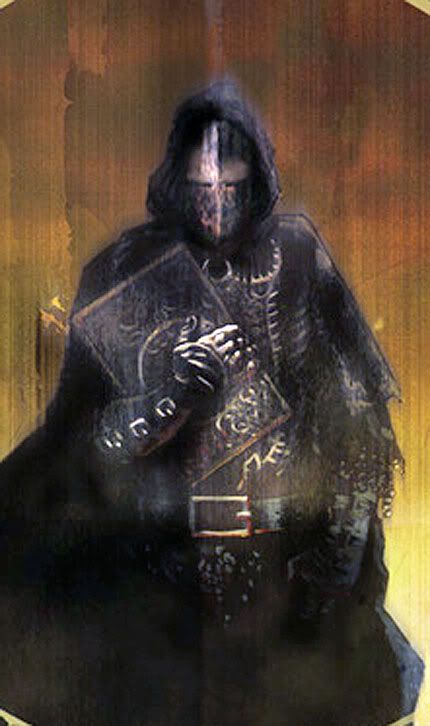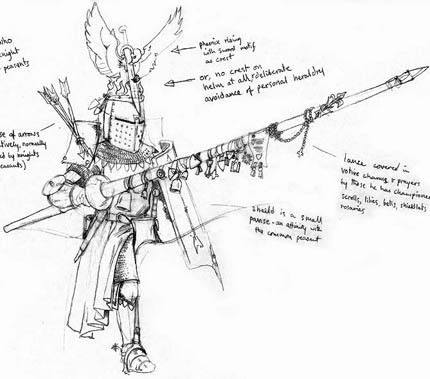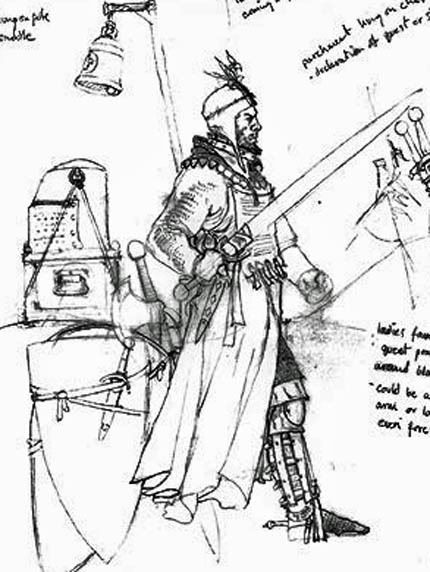The word Paladin derives from the Latin palatinus, meaning, “attached to the palace”, and refers to the twelve Peers of Charlemagne. These men were seen as the best of the best, equal to the King in nobility, valor, and skill at arms. The term eventually came to be a descriptive title applied to those knights, of any country, which exemplified the virtues of the chivalric code, especially knightly prowess in battle.
The paladin character class of Wyrd Greyhawk has as its foundation the AD&D paladin listed in the Player’s Handbook. The changes I’m making to the class are as much a matter of enhancing the flavor and atmosphere of the setting as they are adjustments to the mechanics of the class. The minimum stat requirements remain the same, Str 12, Int 9, Wis 13, Con 9, except that I’m eliminating the Charisma minimum. The paladins of Wyrd Greyhawk are not necessarily leaders of men. Many of them could be seen as Hermit Knights, or armored street preachers, or martial mystics as much as the standard expectation of a devout and selfless fighting man who lives to protect the weak from evil.
My setting is heavily medievalesque, but not exclusively so. The medieval/chivalric themes and attitudes must be altered to fit a world of lusty pulp adventure where life is red in tooth and claw, and the things of the Outer Dark hunger after blood and souls. The paladin class is populated by characters who are Chivalric idealists, but Wyrd Greyhawk is a grim and earthy world and the paladin goes about his work knowing that the greater share of humanity is self interested and uncaring, and that living by his ideals will almost certainly cost him his life. He does so anyway, because Right must be served. Solomon Kane is probably the best fictional character model for what I’m shooting for with the Wyrd paladin.
The paladins of Wyrd Greyhawk are driven men. They are as they are because they can be nothing else. A paladin has been chosen by a God to promote his cause as an emissary and exemplar of the deity’s ethos. Always are the God’s eyes upon the paladin, always he feels the God’s guiding hand upon his shoulder. NPC paladins are very rare. A kingdom may have only a handful. Even Nyrond or Furyondy hold no more than a dozen paladins each. A PC paladin will be close to unique in the campaign, and unlikely to meet others of the class.
A paladin can only be of Lawful Good alignment. Only Gods of this alignment will have paladins in their service. In Wyrd Greyhawk this includes Pelor, Pholtus, Heironious, Cuthbert, the Great God, and The One God. A paladin may be devoted to one of these gods, or more than one, save in the case of the One God, whose worshippers acknowledge no other. Which ever of these Gods the paladin reveres will affect the priorities of his personal Code of Chivalry.
This code of knightly conduct which a paladin observes varies from place to place, with some aspects emphasized while others are downplayed depending upon the ethos of the divinity with which the paladin is associated. Honor, Duty and self sacrifice are at the core of all variants of the chivalric code. A knight should display such virtues as courage, a willingness to give his own life for another’s, mercy, valor in war, skill at arms, justice and protection for the poor or weak, fairness, obedience and faithfulness to his God, generosity, graciousness to women, etc…

The exact virtues and expectations of the code, as well as which aspects carry the most weight in determining the correct course of action a paladin should take in any given situation depend upon the virtues particular to each paladin’s version of the code. When a PC paladin is created, the exact nature of his code of chivalry must be defined in writing. Once the PC paladin’s code of chivalry has been determined, the DM must enforce it ruthlessly. Adherence to the code, or failure to do so, supersedes alignment as the determining factor in deciding whether or not a paladin has access to his paladin’s abilities.
The code of a paladin of Pholtus includes the following tenets, observed in this order of precedence.
1. Obedience to Law
2. Never shirk a just task
3. Defense of any charge unto death
4. Order is the path to Rightness
5. Noble service dutifully rendered
6. The light must be shown to those who know it not
7. Respect for peers and equals
8. Obedience and respect from those beneath your station
9. Protection and justice for the weak
10. Prowess in battle is the test of righteousness
The chivalrous code of a paladin of Heironeous or of Pelor will be different, containing elements that are the same, or which overlap, but likely in a different order of importance, and certainly including different ideals. This means that though all paladins are Lawful Good in alignment, they will by no means think and act alike. Conflict between paladins upholding different codes and others of Lawful Good alignment over the proper course of action in a given situation is not unlikely.
I’m using a version of the Hackmaster 4E Honor system to determine when a paladin may or may not draw on his class abilities. The paladin’s scores in the class’s prime requisites, Str, Int, Wis, Con, are averaged to yield a base Knightly Virtue Score. Violations of the paladin’s code of chivalry or alignment cause penalties to accrue. Exemplary conduct receives bonuses. If penalties push the paladin’s Knightly Virtue Score below its base value, his class abilities are diminished, or unavailable, and remain so until suitable penance has been made. Likewise, bonuses may increase the power or duration of a paladin’s abilities. Bonuses, however, are more difficult to earn, and do not carry over from day to day.
A paladin who violates the code of chivalry looses his paladin’s abilities, becoming an ordinary knight, but may regain them with effort. A paladin who violates his alignment, Falls, and is forever more, a mere fighter.

A paladin, who keeps the code and acts in accordance with his alignment, may;
1. Detect evil up to 600 feet away, as often as desired, providing that the paladin is concentrating on detecting the presence of evil and seeking it in the correct general direction.
2. A paladin makes all saving throws at +2.
3. A paladin may “lay on hands” once per day. This heals 2 hit points worth of damage per level of experience of the paladin. A paladin may only heal others in this manner, he may not heal himself.
4. A paladin is immune to all forms of disease.
5. Once per week, a paladin may cure disease of any sort, magical or natural in origin.
6. A paladin may create a 10 foot radius Circle of Protection from Evil so long as he concentrates on maintaining the protection and performs no other actions. He may move at ½ normal movement rate, but may not attack and maintain the protection at the same time.
7. At the 3rd level of experience, a paladin gains the ability to Rebuke the undead, demons, devils, or other similar malignant extra planar creatures in a manner similar to the cleric’s ability to Turn undead. Monsters in this category with hit dice equal to or fewer than the paladin’s experience level must Save or be driven from his immediate presence by the power of his holy words. Those who Save may still not approach the paladin unless attacked first.
8. If a paladin manages to gain possession of a “Holy Sword”, he may dispel magic in a 10 foot radius at the level of magic use equal to his level of experience. To do this, he must raise the sword, unsheathed, above his head and concentrate on no other task. Dispelling magic in this manner employs the power of the paladin’s divinity directly, and will invite the attention, and probable judgment of the deity.
9. A paladin, in straits most dire, may, 1% chance cumulative per level, receive divine aid in the form of an unexpected ally whose powers and abilities are just enough to level the field of battle and give the paladin a fighting chance of prevailing. The Cry for Succor is not to be given lightly, the paladin’s divine patron will consider it no small thing, and there will likely be strings attached. The paladin’s Knightly Virtue Score will add to or subtract from the chance of the divine patron sending aid. It is possible that the ally will become a henchman or boon companion at the DM’s discretion.
10. A paladin who receives divine healing from a cleric who reveres the same God as the paladin will always gain the maximum benefit possible from the spell.
11. Any normal creature the paladin employs as a mount will always give its utmost efforts.
12. A paladin gains +1 to initiative.
The standard AD&D restrictions on equipment remain in force.
1. A paladin may not own more than 10 total magic items, including 1 suit of armor, 1 shield, 4 weapons, and 4 magic items of other types.
2. A paladin may not retain wealth, keeping only enough coin to pay for his immediate needs until he reaches 10th level, after which point, he may keep monies sufficient to pay for the construction and staffing of a small castle.
3. A paladin will have only associates of congenial ethos if at all possible. It is very often not. Whether or not a paladin may interact with other PCs or NPCs of conflicting alignments, and for how long, or for what purpose, depends upon the paladin’s code of chivalry. The DM will pass hints to the player in the form of omens, feelings, or events to make the wishes of the paladin’s divine patron clear. Failure by the paladin to keep to his code will of course result in penalties being applied to his Knightly Virtue Score.
The paladin class is probably the least pulpy and Sword & Sorcery friendly class of any of the AD&D classes. Even the cleric is an easier fit, at least in my eyes, with its Van Helsing like origin as the nemesis of the infamous Sir Fang. The paladin come from a separate literary tradition, chivalrous romance, and approaches the themes of sword fantasy from the direction of a different set of assumptions about right, wrong, and the purpose of adventure.
This doesn’t make the paladin incompatible with the fighter, magic-user, thief, or cleric, or the world they inhabit, I don’t think. AD&D is an amalgamation of the many sorts of fantastic escapism popular at the time of it’s writing, as today’s editions are as well. The Wyrd-paladin is just my attempt to smooth the seams and joints between the paladin and the other classes, and also the version of Greyhawk I run.
I’m really just doing this for my own enjoyment; I don’t have any players who would consider running a paladin of any stripe. I think the class probably also suffers from all the contemporary social baggage it has to lug around as much as all the restrictions it carries in play. It seems to be largely assumed that a paladin is by definition a self righteous, holier than thou, jackass closet Nazi. I suppose it’s the sophisticated modern attitude that no person of religious devotion or feeling can also be a genuinely good and well meaning person.
The paladin is a necessary part of Wyrd Greyhawk though, even if no players chose to run one, they’re present in the game world. Meeting an NPC paladin is like dealing with a force of nature. They are not dissuaded or persuaded, and a God stands behind them. A powerful NPC paladin is something like a dragon of good, in so far as how the party must carefully consider what actions to take in dealing with him. A paladin is intractable, resolute, and a force to be reckoned with.

The black and white sketches are bits I've clipped from concept art for knights of Brettonia from Warhammer. I don't know who did the color piece, though I'm sure I've seen it used in some gaming product before. I just found it on the net labled,"monk". I like it though.

I'd jump at the opportunity to play one of these Paladins! :D
ReplyDelete--An excellent post and idea(s). :)
I find this interesting. I think I would like to run paladins this way too... I was never a fan of them as player characters. I'm actually thinking that, when (if?) I ever get my Campaign going, of only allowing characters to start as the basic four classes, and only open up stuff like rangers and paladins and druids if their CHARACTER demonstrates a leaning towards that. BUt I haven't thought it through yet. 8)
ReplyDeleteThe illustrations really set the mood.
ReplyDeleteFantastic stuff! I'm all for mediaeval-ing up D&D and I particularly like the way these paladin's seem somehow more dangerous for all their Lawfullness and Goodness. Dragons of Good is a nice way of putting it.
ReplyDeleteHeh, I bet you'd bring a great deal of righteous Joie de Vivre to the table with a Wyrd-Paladin, Timeshadows!
ReplyDeleteAlso, crap Badger-King! I forgot that part. I was thinking the same thing with the paladin. Making the PC start as a Lawful Good fighter and only allow him to become a Paladin at third level. If he had lived and acted as a paladin must until that point, without any of the advantages of the class.
Maybe a quest for paladin hood with a ritual entreaty to the God in question.
I really dig your take on Greyhawk. The classical-pseudo-medievalism-meets-pulp-fantasy vibe is pretty much how I run my Wilderlands campaign.
ReplyDeleteI had a "moment of clarity" after seeing Pulp Fiction when it first came out--the scene with Samuel L. Jackson quoting the Bible before he makes his hit--I thought, "Wow, that's a paladin!" This post is reminiscent of that take on paladins. Great stuff!
I’m using a version of the Hackmaster 4E Honor system to determine when a paladin may or may not draw on his class abilities.
ReplyDeleteIngenious. And the Grail Knight line art suits them to a tee.
Did you ever see the artwork for the Bretonnian Grail Pilgrims. They're basically religious nutters who carry around dead Grail Knights as totemic relics. Creepy and totally Wyrdhawk IMO.
> self righteous, holier than thou, jackass closet Nazi
ReplyDeleteThat view is largely is fall out from restrictions like
> A paladin will have only associates of congenial ethos if at all possible.
The paladin is required to shun and be a jackass to any player character that isn't compatible with their ethos. Those sorts of association requirements also mean (for a campaign, one-shots it's no biggie) either:
1) player can't play a paladin
2) player can't play an assassin/cleric of wrong stripe/etc
3) DM hand waves that requirement and there's always a (lame) reason that the paladin must yet again adventure with those they should be smiting.
Since it always ends up being #3 I always remove/ignore party composition requirements from any class.
But, really awesome paladin flavor!
Chris, I've got a great image of a "Reliquary Knight" that must be for the Grail Pilgrims. I had'nt heard of them before, but I like the idea.
ReplyDeleteI think I could work that into Wyrd Greyhawk. Maybe Paladin groupies who idolize their dead heros and carry their remains with them as they try to evangelize the paladin into Godhood.
Sir Larkins, "I'm trying real hard to be the shepard."
ReplyDeletethe shepherd quote plus the painting made it all click for me. sold.
ReplyDeleteThanks,Zak! Shall I wrap that for you, or will you eat it here?
ReplyDeleteHave it delivered to this address by game-time friday:
ReplyDeletehttp://dndwithpornstars.blogspot.com/2010/04/now-taking-odds-for-assault-on-fortress.html
Done!
ReplyDeleteChello!
ReplyDeleteVery nice take on the paladin.
I have to disagree with some of the other posters, though. The paladin isn't in the wrong...it's the players running evil characters who are...;)
Inspirational stuff, sir! I drew on this heavily in trying to flesh out their Mesopotamian counterparts for a bronze age/Near Eastern campaign: "the pious sword is indeed sharp; the pure mace, surpassing heavy!"
ReplyDelete